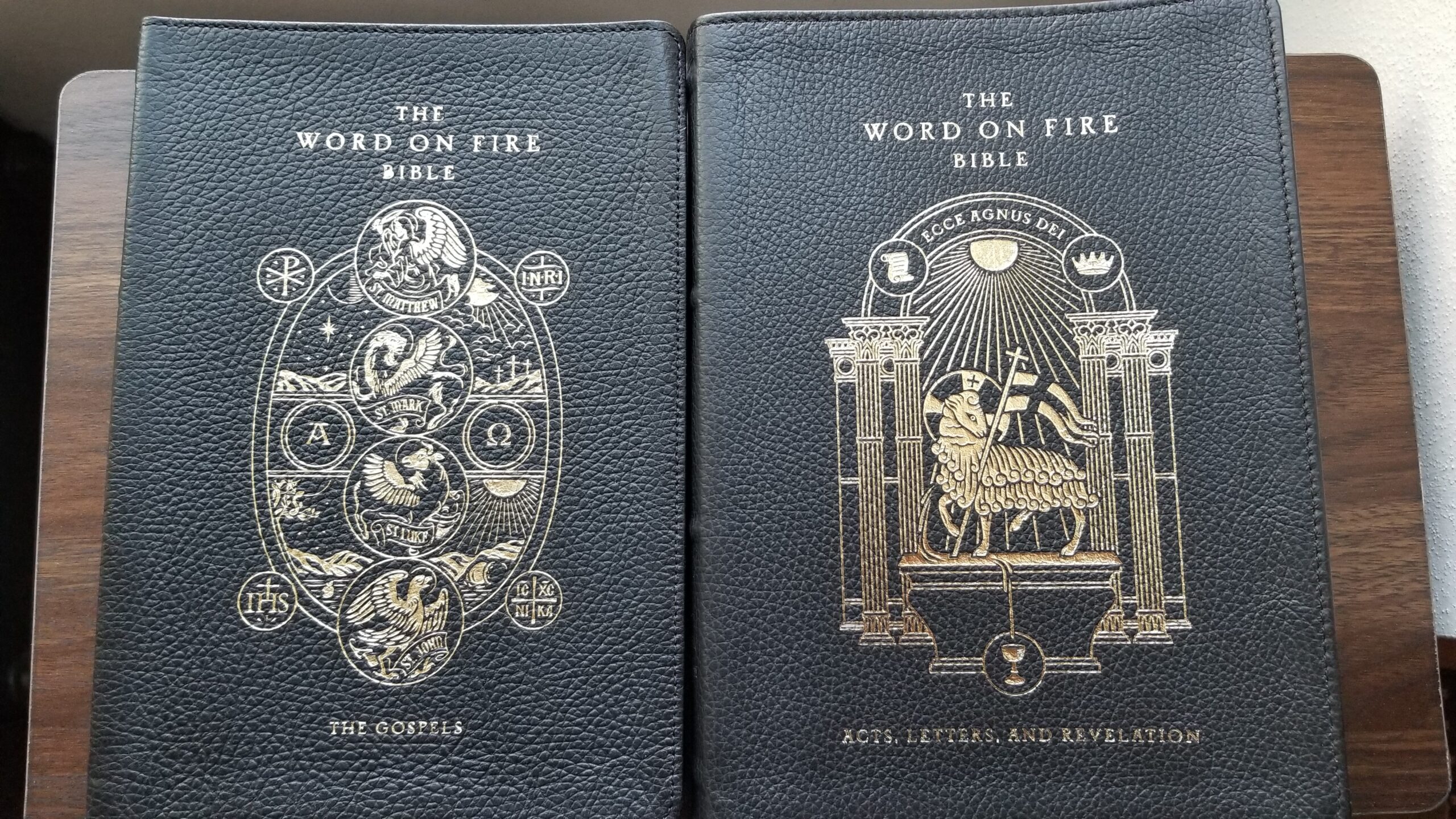
The time has almost arrived for Volume 2 of the Word on Fire Bible to be released. A year and a half ago, I reviewed the first volume which included the four gospels here. The second volume will include the rest of the New Testament, from the Acts of the Apostles to Revelation. The publication date is set for Monday, January 17th — five days from today! I’m grateful to Word on Fire for providing me with an advance copy of the leather edition for review, and I’ll cover the physical details and a basic overview in this first installment of my review.
Bible Translation, Layout, and Commentary
First of all, to address a question that has come up a few times recently: this volume uses the New Revised Standard Version — Catholic Edition (NRSV-CE) copyrighted in 1989 and 1993. The updated edition of the NRSV has not been used here. This is the same translation choice as volume 1, and it makes sense to keep the translation consistent. Here is a photo of the copyright page with details on the translation and other commentaries used in this volume:
The page layout inside Volume 2 follows an identical style to volume 1. The biblical text is printed in single-column format with a serif font and ample margins. Commentary by Bishop Barron is printed in double-column format with a sans-serif font, and commentary from theologians, fathers of the Church, ecumenical councils, and saints are printed with color backgrounds in single-column format. Here is an example page from the Acts of the Apostles:
At the top of the left-hand page, Bishop Barron’s comments are printed in double-column format. In the middle of the left page, a quote from St. John Chrysostom is highlighted with a color background, and at the bottom of the left page the biblical text is printed in single-column format.
Important or famous verses are occasionally highlighted with a special inset that reprints the verse in prominent, large font as shown above. Here is another example from Romans 6:23:
Volume 2 also continues the Via Pulchritudinis (Way of Beauty) inserts from Volume 1. These are two-page sections with high-quality color images of artwork and commentary by Michael Stevens on the symbolism and spiritual significance of the artwork. These features are interspersed throughout the text, and the artwork either depicts a scene directly from the biblical text, or it contains themes that are relevant to the text.
Bishop Barron has commented on the value of beauty for evangelization. Going all the way back to Plato and Aristotle, philosophers have written about the fundamental properties of Being. There are varying lists of these fundamental or “transcendental” properties (see a more thorough explanation from Fr. Robert Spitzer’s Magis Center here), but one of the commonly-used lists is: truth, goodness, and beauty. These transcendentals are universal values, and since God is Being itself, they are expressions of God. In the postmodern world, truth and goodness have been questioned repeatedly, and many people are skeptical of universal claims to truth or goodness. But beauty is something that can be immediately compelling and striking. It has a way of breaking through the defenses of the most ardent skeptic.
This is a guiding principle behind the design of the Word on Fire Bible project. The volumes are high-quality and constructed in a way that is befitting for a sacred book. The artwork provides an avenue for encountering God that is missing from many other Bibles.
On the other hand, I think it’s worth emphasizing that this Bible does not sacrifice truth and goodness in favor of beauty. Firstly, the text of Sacred Scripture is here, and the commentary continues in the tradition of Volume 1 — breaking open the meaning and significance of Scripture and presenting pointed, homiletic commentary to the reader on its relevance for living life. I’ll delve into the commentary in more depth in part 2 of my review.
Physical Details
Volume 2’s physical design is largely identical to Volume 1. There are no jarring design changes here. The quality of the leather cover is quite similar to Volume 1. In my previous review, I described Volume 1’s leather as similar to the French Morocco leather from Cambridge University Press. It is not as good as premium goatskin (like the Schuyler Quentel ESV or the Cambridge Reference NRSV), but it is nicer than the bonded leather on the Oxford NABRE Catholic Study Bible or the genuine leather cover on the Oxford Large-Print NABRE.
The gold gilding on the page edges is excellent. It is highly-reflective with an almost mirror-like quality. In appearance, this gilding is on-par with the Cambridge premium Reference NRSV.
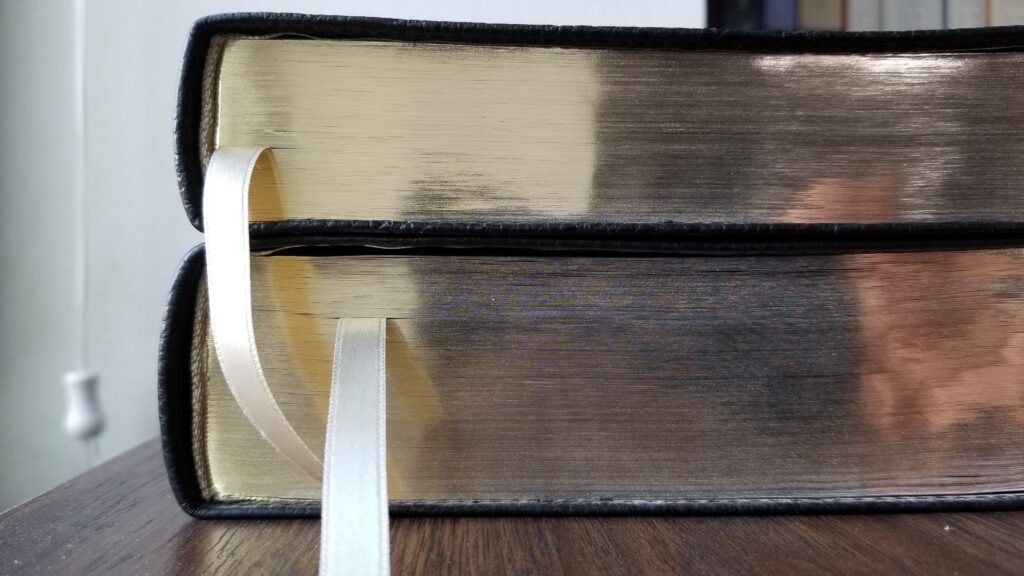
Both volumes 1 and 2 feature a sewn binding with thick, semi-glossy paper. Ghosting of text from subsequent pages is minimal but not non-existent. It does not impact ease of reading. The semi-glossy pages occasionally reflect light in a way that makes it difficult to take good pictures. Here’s an example from a Via Pulchritudinis excerpt:
Overall, I have not noticed a problem with glare while reading. I’m currently reading through Paul’s letter to the Romans and haven’t experienced any annoyance or frustration. I normally do not read under a lamp, though, so some readers might experience more trouble with glare than I have.
It’s also worth mentioning that the thick paper is not very flexible compared to normal thin bible paper. This Bible does not lay flat easily, so it will be necessary to hold it open while reading.
Similar to Volume 1, there is one 1/4-inch double-sided ribbon marker.
Overall, I am still very impressed with the quality of materials here. In some ways, I wonder if this Bible is “too nice.” I worry that people will be so protective of it that they will not pull it off the shelf (or the coffee table) to absorb the excellent material this Bible offers. As Timothy has noted in his book and a post here, there is much to be said for having a Bible that you can “live in” and use until it’s worn out. Here’s hoping that Catholics and non-Catholics will not be afraid to wear out the Word on Fire Bible and learn and grow with it during their lives of faith.
Volume 2 will be available in paperback, hardcover, and genuine leather just like Volume 1. Here is a link to Word on Fire’s countdown webpage for Volume 2. Stay tuned for the second part, where I’ll delve into more detail on the commentary.
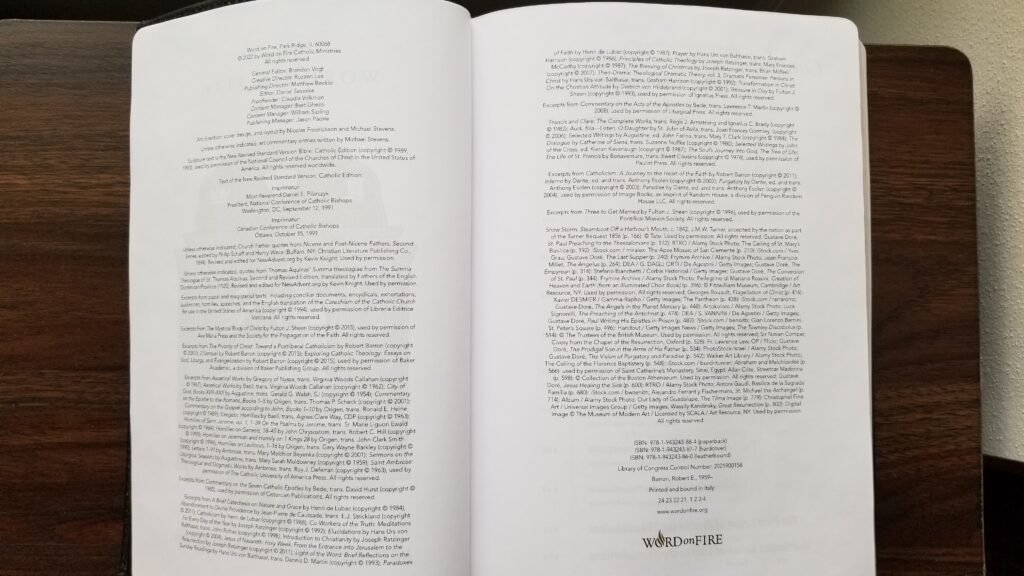
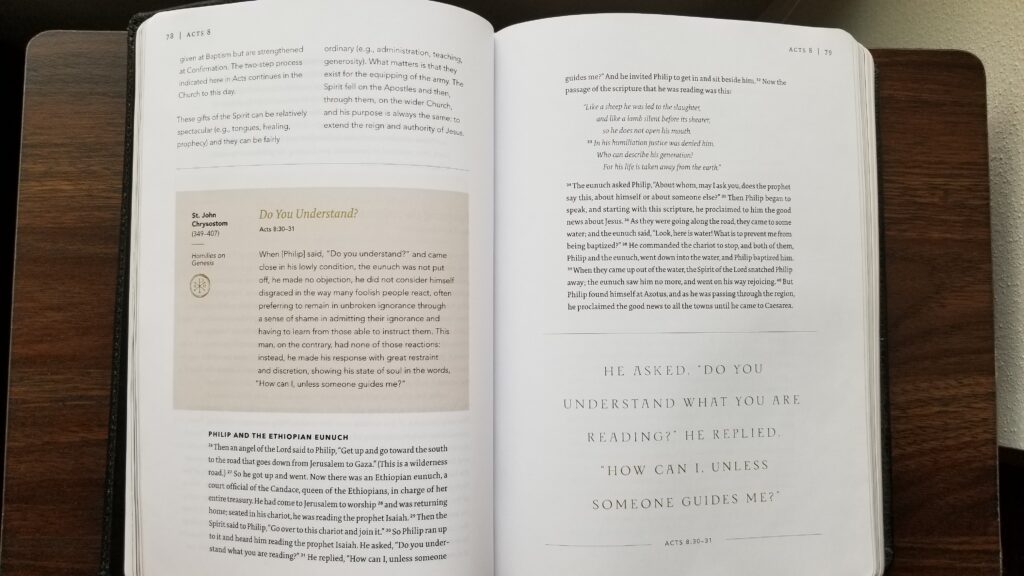
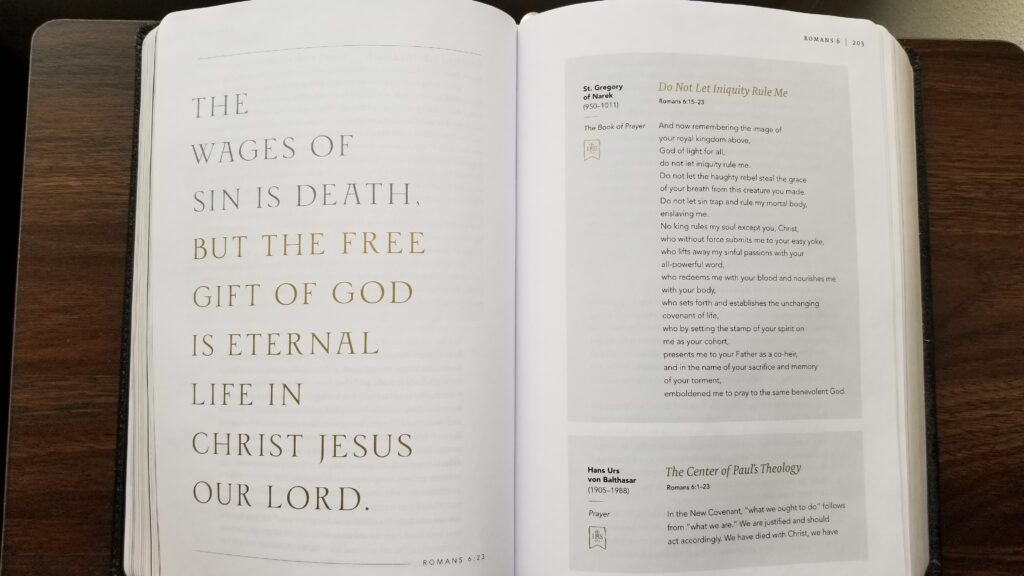
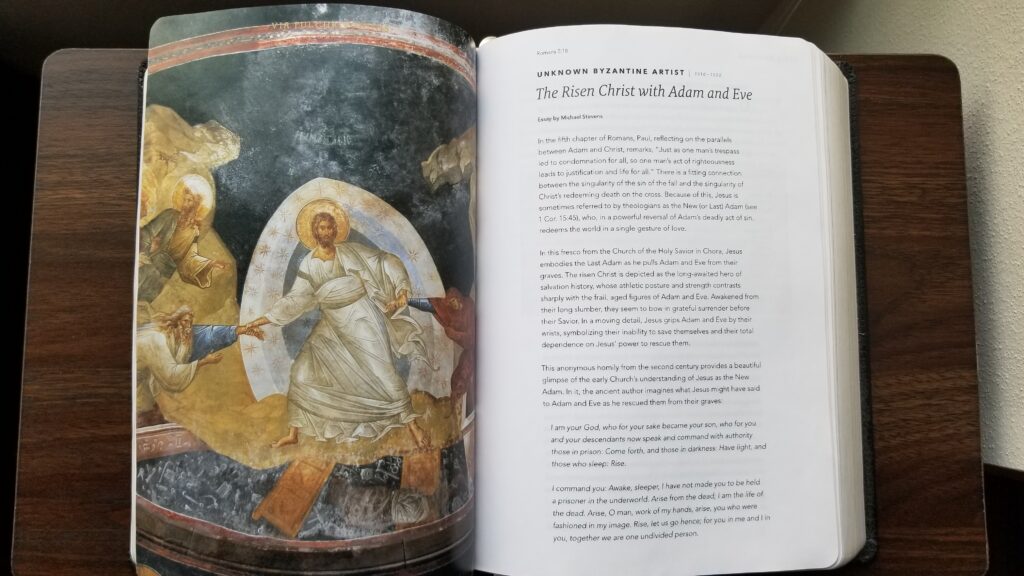
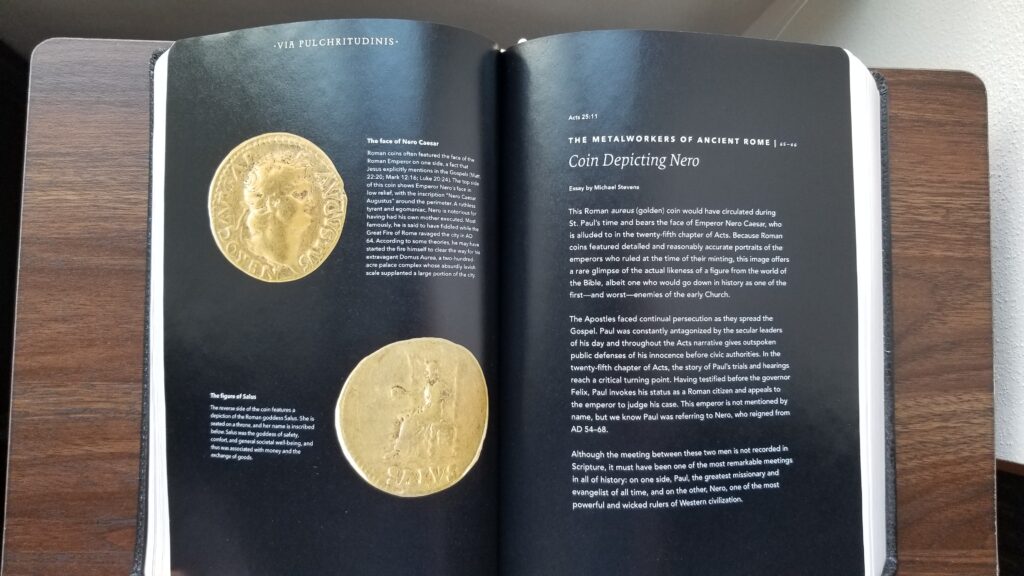
It looks stellar! Curious if the pricing will match Vol. 1 or will be higher since it’s a thicker volume. I also agree that you shouldn’t be afraid to wear out even a nice, custom-rebound goatskin Bible. The Bible is for reading, and a lot of it! My solution with any of these fancy editions that come in boxes is simply to pull them out of the box and place the box into the closet. Constantly reboxing your Bible between readings can make you too obsessive about keeping it from even looking like it’s been used, which defeats the purpose. That said, I’ll confess that I still can’t bring myself to write in any of mine. Maybe one day I’ll get an Ignatius journaling Bible and start transferring notebooks of notes into it. Anyway, can’t wait to one day have a full lineup of WOF volumes, NT and OT.
Price is 69.95 for the leather plus shipping. Not cheap
Thanks for the review. I hope this edition is not an advertisement for Vatican II. Bp Barron and the Word on Fire crowd seem to think that Catholicism began in 1965.
We are Catholics who practice our Faith as post Vatican II Catholics. Thus, to ignore it might be, as said in the Canons of the Council of Trent be anathema. If one were to look at newer Council Documents, encyclicals etc. they present their views as extending or clarifying older documents or councils, but, to my knowledge, rarely do they say ignore the former documents. However, you must now read the old document in the context of the new document; that is not an option. To ignore what Vatican II and the post-Vatican II documents say is “anathema.” This is our Magisterium which we believe comes from the Holy Spirit. To ignore what writers “think” they say, that is very much open to debate.
1. I am not a “post Vatican II Catholic,” whatever that is. I am a Catholic.
2. When did I ever say above that we should “ignore” Vatican II documents?
3. Sorry, but Catholics do not read “old documents” in the context of “new documents.” That is nihilism. Rather, anything “new” must be read in light of Tradition.
“However, you must now read the old document in the context of the new document; that is not an option.”
I have to agree with the other Jim here. That is precisely backwards. We read the new in light and context of the old. Doing it the other skates pretty close to implying continuous revelation, and is specifically foreclosed. As Vatican I put it:
“Hence, too, that meaning of the sacred dogmas is ever to be maintained which has once been declared by Holy mother Church, and there must never be any abandonment of this sense under the pretext or in the name of a more profound understanding.
May understanding, knowledge and wisdom increase as ages and centuries roll along, and greatly and vigorously flourish, in each and all, in the individual and the whole Church: but this only in its own proper kind, that is to say, in the same doctrine, the same sense, and the same understanding.”
I know Card. Schonborn said something to the effect of what you mention a few years ago (it was about re-understanding all traditional Church teaching on marriage in light of Amoris Laetitia, rather than trying to understand Amoris laetitia in light of traditional Church teaching) but in this instance at least, he was simply wrong. There is no “retconning” of the Gospel, nor are we obliged to believe that there is.
^ that comment by Jim is just ignorant. Near all of the art in each editions is before Vatican 2. As well as many of the commentary quotes from the saints and doctors of the Church. Well anyway I do agree that the leather editions are so nice that I have kept my volume 1 in the box since I purchased it but the paperback is great and not too pricey so I recommend buying the paperback if you plan on using it as an everyday bible.
That’s good to hear, Tony. Most “post-Vatican II” art and architecture is hideous. E.g., the Cathedral in Los Angeles, or the promotional flyers for the current “synod on synodality.”
I have to retract my earlier criticisms of commercialism of the first Vol and marketing of WOF Bible. After using it for a year and many many times being struck by reading Bishop Barron’s commentary after reading the relevant passage, I adore this project and will eagerly buy Vol 2 as soon as it’s available
I donated some money to WOF when they were advertising thank-you gifts of this edition when it came out. I was pleasantly surprised to find it on my doorstep nearly a month before the official publication date! Very happy with this bible, there are many great insights within and it is so beautiful that my protestant wife likes working it into her foyer decorations.
The countdown clock is for tomorrow but I was able to order as of Sunday on their website. Leather bound incoming.
Same. I logged on earlier today and noticed that it was stocked. Grabbed the leather Vol. 2 and a copy of Food for the Soul. Looking forward to them!
Received mine today. Big sucker, seems more like a full Bible in girth. Exactly the same layout and quality as Vol 1. I’m happy
After using Vol 2 for a bit it IS a bit bulky and heavy for a “lap Bible”. But I enjoy it because the Gospels and the Acts/Letters lend themselves to reading straight through in a session like a novel. But given the size of Vol 2, I have to wonder if Catholics are going to buy the future volumes of the OT with the same ardor or will it be a NT thing for most.. I myself can’t see buying two volumes of The Histories at this same size and format.
I will likely not be buying any further WOF Bibles. These 2 are fine.